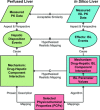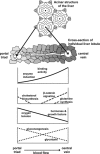Tissue-level modeling of xenobiotic metabolism in liver: An emerging tool for enabling clinical translational research
- PMID: 20443896
- PMCID: PMC3068531
- DOI: 10.1111/j.1752-8062.2009.00092.x
Tissue-level modeling of xenobiotic metabolism in liver: An emerging tool for enabling clinical translational research
Abstract
This review summarizes some of the recent developments and identifies critical challenges associated with in vitro and in silico representations of the liver and assesses the translational potential of these models in the quest of rationalizing the process of evaluating drug efficacy and toxicity. It discusses a wide range of research efforts that have produced, during recent years, quantitative descriptions and conceptual as well as computational models of hepatic processes such as biotransport and biotransformation, intra- and intercellular signal transduction, detoxification, etc. The above mentioned research efforts cover multiple scales of biological organization, from molecule-molecule interactions to reaction network and cellular and histological dynamics, and have resulted in a rapidly evolving knowledge base for a "systems biology of the liver." Virtual organ/organism formulations represent integrative implementations of particular elements of this knowledge base, usually oriented toward the study of specific biological endpoints, and provide frameworks for translating the systems biology concepts into computational tools for quantitative prediction of responses to stressors and hypothesis generation for experimental design.
Figures







Similar articles
-
Modeling of xenobiotic transport and metabolism in virtual hepatic lobule models.PLoS One. 2018 Sep 13;13(9):e0198060. doi: 10.1371/journal.pone.0198060. eCollection 2018. PLoS One. 2018. PMID: 30212461 Free PMC article.
-
Computational tools for modeling xenometabolism of the human gut microbiota.Trends Biotechnol. 2014 Mar;32(3):157-65. doi: 10.1016/j.tibtech.2014.01.005. Epub 2014 Feb 13. Trends Biotechnol. 2014. PMID: 24529988 Review.
-
In silico techniques for the study and prediction of xenobiotic metabolism: a review.Xenobiotica. 2005 Oct-Nov;35(10-11):955-73. doi: 10.1080/00498250500354402. Xenobiotica. 2005. PMID: 16393855 Review.
-
Sex-dependent metabolism of xenobiotics.Drug Metab Rev. 1998 Aug;30(3):441-98. doi: 10.3109/03602539808996322. Drug Metab Rev. 1998. PMID: 9710703 Review.
-
Dermatokinetics: Advances and Experimental Models, Focus on Skin Metabolism.Curr Drug Metab. 2022 Aug 3;23(5):340-354. doi: 10.2174/1389200223666220517114004. Curr Drug Metab. 2022. PMID: 35585827 Review.
Cited by
-
Representative Sinusoids for Hepatic Four-Scale Pharmacokinetics Simulations.PLoS One. 2015 Jul 29;10(7):e0133653. doi: 10.1371/journal.pone.0133653. eCollection 2015. PLoS One. 2015. PMID: 26222615 Free PMC article.
-
Protective effect of aged garlic extracts against hepatotoxicity induced by ethephon in Wistar albino rat.Environ Sci Pollut Res Int. 2020 Feb;27(6):6139-6147. doi: 10.1007/s11356-019-07148-w. Epub 2019 Dec 21. Environ Sci Pollut Res Int. 2020. PMID: 31865585
-
A multiscale modelling approach to assess the impact of metabolic zonation and microperfusion on the hepatic carbohydrate metabolism.PLoS Comput Biol. 2018 Feb 15;14(2):e1006005. doi: 10.1371/journal.pcbi.1006005. eCollection 2018 Feb. PLoS Comput Biol. 2018. PMID: 29447152 Free PMC article.
-
An improved nonlinear model describing the hepatic pharmacokinetics of digoxin: evidence for two functionally different uptake systems and saturable binding.Pharm Res. 2010 Sep;27(9):1999-2007. doi: 10.1007/s11095-010-0204-9. Epub 2010 Jul 13. Pharm Res. 2010. PMID: 20625800
-
Spatio-temporal simulation of first pass drug perfusion in the liver.PLoS Comput Biol. 2014 Mar 13;10(3):e1003499. doi: 10.1371/journal.pcbi.1003499. eCollection 2014 Mar. PLoS Comput Biol. 2014. PMID: 24625393 Free PMC article.
References
-
- Merrick BA. Toxicoproteomics in liver injury and inflammation. Ann N YAcod Sci. 2006; 1076 707–717. - PubMed
-
- Dome JL, Skinner L, Frampton GK, Spurgeon DJ, Ragas AM. Human and environmental risk assessment of pharmaceuticals: differences, similarities, lessons from toxicology. Anal Bioonol Chem. 2007; 387(4): 1259–1268. - PubMed
-
- Burke W, Psaty BM. Personalized medicine in the era of genomics. JAMA. 2007; 298(14) 1682–1684. - PubMed
-
- Liu ET. Expression genomics and drug development: towards predictive pharmacology. Brief Fund Cenomic Proteomic. 2005; 3(4): 303–321. - PubMed
-
- Hunt CA, Ropella GE, Yan L, Hung DY, Roberts MS. Physiologically based synthetic models of hepatic disposition. J Pharmacokinet Pharmacodyn. 2006; 33(6): 737–772 - PubMed
Publication types
MeSH terms
Substances
Grants and funding
LinkOut - more resources
Full Text Sources

